3D IMAX 70mm today
|
Read more
at in70mm.com The 70mm Newsletter |
| Written and photographed by: Gerhard Witte, Berlin, Germany | Date: 01.07.2010 |
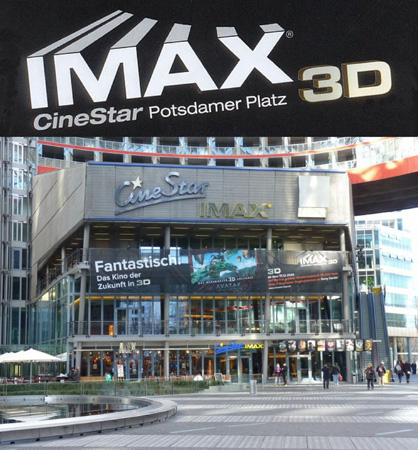 The CineStar IMAX cinema in Berlin The CineStar IMAX cinema in Berlin
IMAX - a made-in-Canada super-sized film format was presented publicly for the first time at World Fair Osaka 1970 with the short film “Tiger Child”. The first world wide permanent IMAX projection system (cinema: The Cinesphere) was installed at Ontario Place in Toronto, Canada in 1971. With the film "Transitions", which was a little over 20 minutes long and was produced by the National Film Board of Canada, IMAX 3D was shown for the first time at EXPO 1986 Vancouver. Nowadays a considerably higher image quality is achieved if the analogue 3D dual-strip process is shown with two 70mm films in an IMAX cinema, as happens here in Berlin in the IMAX cinema in the Sony Center: It has over 537 seats. The screen is 21x28 metres (588 square metres) and consists of sound-permeable (perforated) metallic-coated stretch vinyl. The cinema was opened on 20.01.2000 and is part of the CineStar Multiplex (CineStar Original) on Potsdamer Platz, which includes a further 8 cinemas. |
More
in 70mm reading: 3D in the mid 60s in Europe with Hi-Fi Stereo 70 3D IMAX 70mm heute MCS 70 - Superpanorama The Grindel Filmtheater The "Savoy" in Hamburg The Shoes Of The Fisherman Internet link: Berlin Cinema Compendium Kinomuseum Berlin e.V. The Holographic Studio of the Scientific Research Cinema & Photo Institute Chace Audio The life of Willi Burth The Film- and Televisionmuseum Hamburg List of 3D-Films List of pre-2005 3D films |
|
|
|
 The
IMAX 70mm double projector (twin projector), open at the front with the film
removed. It has two 15 kW projection lamps (water and air-cooled xenon gas
discharge lamps). The weight of the projector is about 1.8 tonnes. There is
a 35mm projector in front on the left. The curly orange hose lying on the
ground is a compressed-air hose which is used for the cleaning of the
projector's optical systems. The
IMAX 70mm double projector (twin projector), open at the front with the film
removed. It has two 15 kW projection lamps (water and air-cooled xenon gas
discharge lamps). The weight of the projector is about 1.8 tonnes. There is
a 35mm projector in front on the left. The curly orange hose lying on the
ground is a compressed-air hose which is used for the cleaning of the
projector's optical systems. |
|
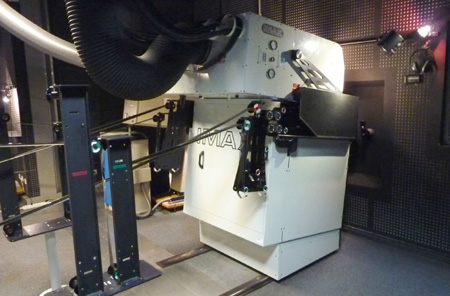 Double projection with two IMAX 15Perf/70mm films running from the right to
left site of the projector. Please note the volumious service connections
for the water- and air cooling supply. Double projection with two IMAX 15Perf/70mm films running from the right to
left site of the projector. Please note the volumious service connections
for the water- and air cooling supply.IMAX projectors are the most advanced, precise and powerful projectors that have ever been made. Their image quality and reliability is based on an ingenious solution for the transport of the film, the so-called "rolling loop". |
|
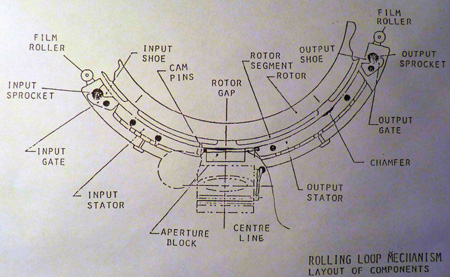 The "rolling loop" (wave loop mechanism) explained by means of a diagram. The "rolling loop" (wave loop mechanism) explained by means of a diagram.This system moves the film forwards horizontally in gentle, wave-like movements (wave loop mechanism) on air pillows and guide rails with the aid of the so-called rolling loop drum (diameter 95.2 cm). During the projection, every frame is stabilised in the area of a loop by locking claw pins to prevent flickering and is sucked by a vacuum on to the back of the projection lens in front of a ground and polished image aperture glass, so that the image is aligned perfectly in front of the lens. The film is protected optimally in this process as there are no forces, such as acceleration and braking, working on it. |
|
 The twin projector with open housing. With the twin projector, the two films
run above one another in rolling-loop drums that are permanently connected
together and the lenses are also fitted above one another. The film for the
left eye is projected at the bottom, the film for the right eye at the top. The twin projector with open housing. With the twin projector, the two films
run above one another in rolling-loop drums that are permanently connected
together and the lenses are also fitted above one another. The film for the
left eye is projected at the bottom, the film for the right eye at the top.
102 metres of film run through the projector per minute at 24 frames/second, which corresponds to a speed of 1.7m/s. A film with a running time of 45 minutes is thus almost 4.6 kilometres long. |
|
 70mm IMAX film (here lying flat in the upper rolling loop drum) in front of
the image aperture glass which is opened to the right for film access, which
can only be seen from above (edge) on the right here. 70mm IMAX film (here lying flat in the upper rolling loop drum) in front of
the image aperture glass which is opened to the right for film access, which
can only be seen from above (edge) on the right here. |
|
 The 70mm IMAX film is pulled out. Top left, light from the xenon gas
discharge lamps can be seen. In front of this is the upper rolling loop drum
with an indentation (there is a total of 8 per drum) for the film loop. In
one indentation exactly fits one IMAX 15Perf/70mm piece of film. The 70mm IMAX film is pulled out. Top left, light from the xenon gas
discharge lamps can be seen. In front of this is the upper rolling loop drum
with an indentation (there is a total of 8 per drum) for the film loop. In
one indentation exactly fits one IMAX 15Perf/70mm piece of film. |
|
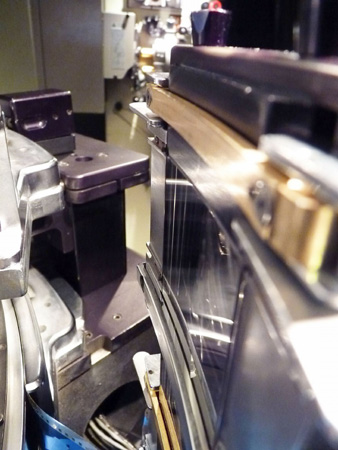 On the right, the upper polished image aperture glass with the upper film
removed. Bottom left, a piece of the inserted second 70mm IMAX film for the
bottom projection can just be seen (3D dual-strip projection). On the right, the upper polished image aperture glass with the upper film
removed. Bottom left, a piece of the inserted second 70mm IMAX film for the
bottom projection can just be seen (3D dual-strip projection). |
|
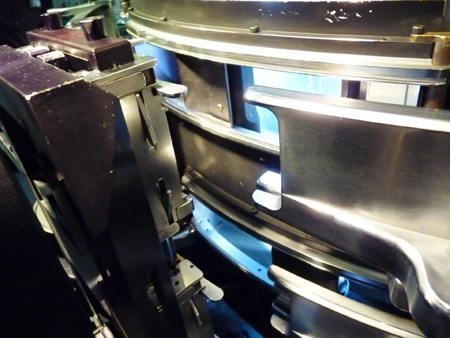 Here on the left, the image aperture glass that has been opened forwards. In
front of this are the two rolling loop drums for the bottom and top film
runs, with the openings for the lights of the two projection lamps
illuminated in blue. Here on the left, the image aperture glass that has been opened forwards. In
front of this are the two rolling loop drums for the bottom and top film
runs, with the openings for the lights of the two projection lamps
illuminated in blue. |
|
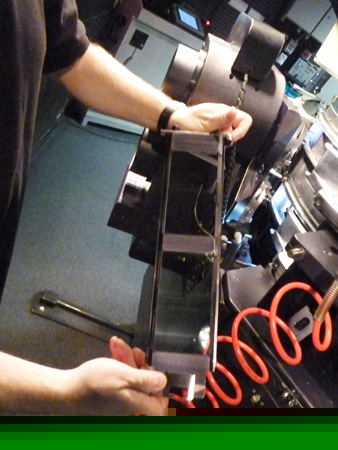 The double image aperture glass can be removed from the projector in an
upwards direction for the purpose of cleaning. The double image aperture glass can be removed from the projector in an
upwards direction for the purpose of cleaning. |
|
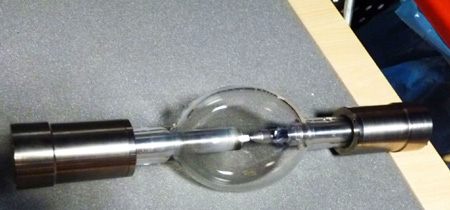 The
15 kW Xenon Gas Discharge Lamp (Xenon Short Arc Lamp), weight 10 pounds The
15 kW Xenon Gas Discharge Lamp (Xenon Short Arc Lamp), weight 10 pounds
Its operating voltage is 37.5 volts with a current consumption of 400 amps. At an operating temperature of approx. 700 degrees C, up to 1.6 cubic metres of air and 36 litres of distilled water per minute are fed through the lamphouse, to cool down the xenon gas discharge lamp. The lamp is very expensive. One tells that the cost is approximately 6000 US dollars, which is approximately 4400 Euros. It should last 1000-1200 hours. |
|
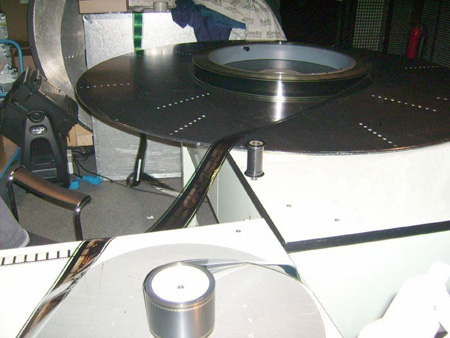 IMAX: 70mm wide film being processed IMAX: 70mm wide film being processed
It is a polyester film that is particularly tear-resistant, with a transverse frame. The spherical individual image (negative) taken by the IMAX camera has a nominal size of 70.41 x 51.61 millimetres (2.772 x 2.032 inches) and is thus the largest image in the history of film. It is 3 times larger than a 5/70mm (Todd-AO) standard image which has a nominal individual image size (negative) of 52.63 x 23.01 millimetres (2.072 x 0.906 inches). The aspect ratio of the IMAX camera image (negative) is 1.364:1 (width to height) - that almost matches the 4:3 TV picture aspect ratio of 1.33:1. The image format of the original standard IMAX 15/70 film projection used until now is 1.433:1. The maximum film image size (projectable image area) is 69.60 x 48.56 millimetres (2.740 x 1.912 inches) and is thus somewhat smaller than the image taken by the camera. The IMAX 15/70 values were established by the Society of Motion Picture and Television Engineers (SMPTE) in the documents Camera Aperture Image and Usage, 15/70 Format and Projectable Image Area, 15/70 Format, in October 2005. In this case (image), notice the narrower projection image with the black stripes at the top and bottom. The film “Avatar” wasn't shot with IMAX cameras, it was shot with HD cameras in a 1.78:1 aspect ratio and normally is shown in letterbox format on the large IMAX screens, that also meets the standard of the 16:9 HDTV format. The analogue 2D version of the film has been released in an aspect ratio of 2.35:1 (CinemaScope) in the cinemas. Here you can't see the whole 1.78:1 picture, it is cropped off at the top and bottom. James Cameron, the director of the film, said: In general I prefer the 2.35:1 format, but for 3D I like the extra screen height for a better immersion. The Blu-ray and DVD editions of the film (2D) came in a 1.78:1 aspect ratio into the shops. |
|
|
|
|
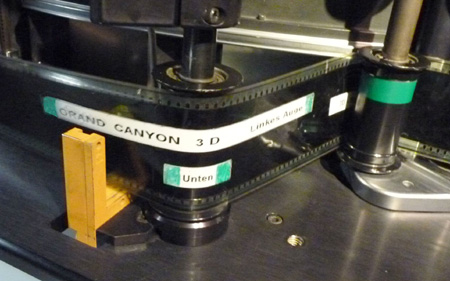 "Grand Canyon" 3D 70mm IMAX film, bottom projection for the left eye at the
bottom on the projector intake. "Grand Canyon" 3D 70mm IMAX film, bottom projection for the left eye at the
bottom on the projector intake. |
|
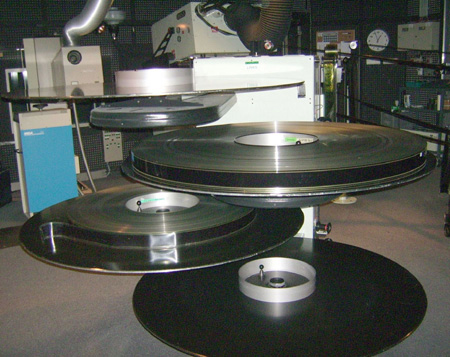 This platter system is a MK-II (Mark Two) REEL UNIT. It is an OUTER FEED
UNIT; here, the start of the film is on the outside - the films must be
re-wound after they have been shown, as is the case with the traditional
vertical film reels. This platter system is a MK-II (Mark Two) REEL UNIT. It is an OUTER FEED
UNIT; here, the start of the film is on the outside - the films must be
re-wound after they have been shown, as is the case with the traditional
vertical film reels. A 2x70mm 3D film copy with a running time of 45 minutes should cost about 33,000 US dollars to buy - that is about 24,300 euros (translation date 04/2010). |
|
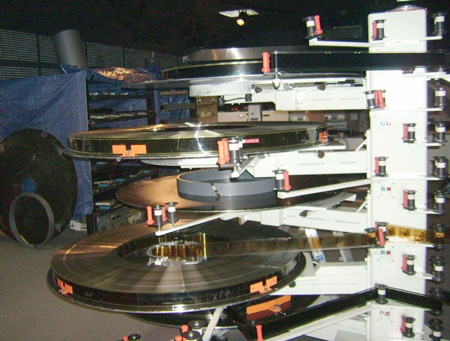 This platter system is a QUICK TURN REEL UNIT (QTRU). It is a CENTRE FEED
UNIT for quick film changeover without re-winding. This platter system is a QUICK TURN REEL UNIT (QTRU). It is a CENTRE FEED
UNIT for quick film changeover without re-winding. Here the start of the film is inside the platter. With the aid of a plug-in unit, it is fed from the centre of the platter (see the picture of the bottom of the platter) to the projector, and then on to another platter. For the next projection (also from inside out) it is therefore in the correct position and does not have to be re-wound. The "no-rewind" film platter was invented by the German pioneer of cinema Willi Burth (10.09.1904-8.12.2001). In 1969 it became world wide patent-registered. In 1987 Willi Burth was rewarded for this with the Scientific and Engineering Award of the Academy of Motion Picture Arts and Sciences. |
|
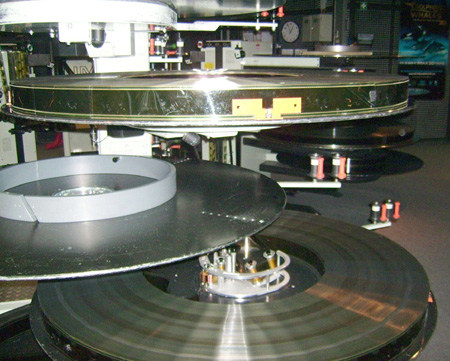 QTRU-Platters, below with plug-in unit QTRU-Platters, below with plug-in unitThere are various platter sizes with a maximum running time of up to about 150 minutes. A platter with a 70mm IMAX film with a running time of 90 to a maximum of 100 minutes (platter diameter just over 1.5 metres) weighs around 175 kg, while the film alone weighs approx. 125 kg. |
|
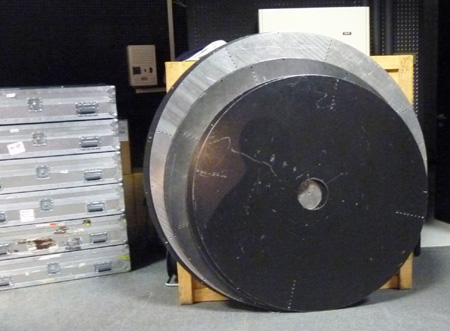 Transport boxes for 70mm IMAX films and various platter sizes in store. Transport boxes for 70mm IMAX films and various platter sizes in store. |
|
 Transport boxes for 70mm IMAX films and trolley Transport boxes for 70mm IMAX films and trolley
|
|
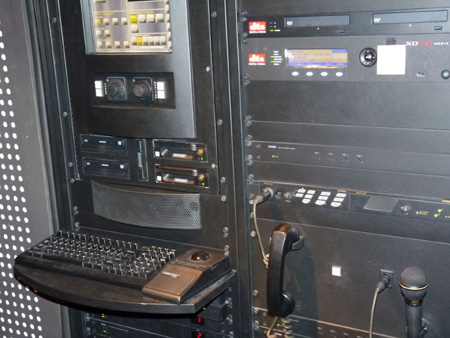 Control
panel for the soundtrack DVDs in the DIGITAL THEATER AUDIO CONTROL (DTAC)
system for the SONICS PROPORTIONAL POINT SOURCE (PPS) loudspeaker system. Control
panel for the soundtrack DVDs in the DIGITAL THEATER AUDIO CONTROL (DTAC)
system for the SONICS PROPORTIONAL POINT SOURCE (PPS) loudspeaker system.
The grandiose "wrap-around" sound, "it's designed to allow the audio to be as large as the picture", is broadcast in this cinema by a 25,000 Watt Surround Digital IMAX/SONICS system. It has 6 discrete channels. From the frequency range around 120 Hertz and lower, the subwoofer system is switched in, which produces very low frequencies down to 20 Hertz. This is not an additional, seventh, so-called Low Frequency Effect (LFE) channel. The information it needs is drawn from all 6 channels. |
|
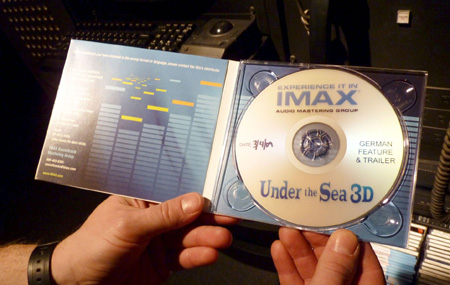 The DVD shown here contains the uncompressed 6-channel German sound for the
film "Under the Sea 3D". The DVD shown here contains the uncompressed 6-channel German sound for the
film "Under the Sea 3D".The loudspeakers for left, right, middle and top middle, together with the deep bass (bottom middle), are positioned behind the screen. The loudspeakers for the respective surround sound are located at the back of the auditorium to the right and left, and they are the same size as the main loudspeakers behind the screen. The acoustics are specially adjusted for each individual IMAX theatre. If need be, up to 44 loudspeakers are used for this, distributed in so-called "clusters" around the room. |
|
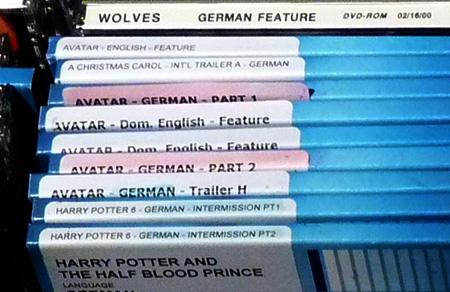 All of the pictures of the IMAX 3D CineStar Theater Berlin were taken by the
author in January 2010. I should also like to express my thanks here to the
staff of the CineStar cinema for their friendly welcome and their readiness
to explain everything to me. All of the pictures of the IMAX 3D CineStar Theater Berlin were taken by the
author in January 2010. I should also like to express my thanks here to the
staff of the CineStar cinema for their friendly welcome and their readiness
to explain everything to me. |
|
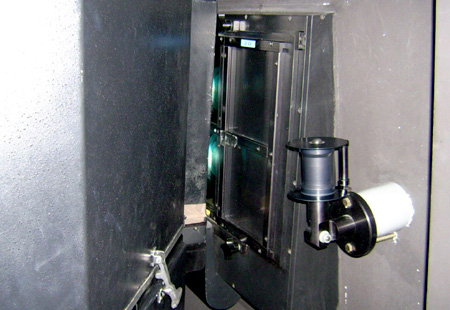 Running
double projection through polarisation filters. The vertical projection
gates
in front are destined for the projection of 2D films. Running
double projection through polarisation filters. The vertical projection
gates
in front are destined for the projection of 2D films.In this report I have attempted to describe how the best possible - but also most expensive - analogue 3D presentation could be achieved in cinemas using 70mm film and how it is still used today with IMAX. What the television set represented in 1955 is today in part represented by improved home cinema technology with its low-cost DVDs and Blu-ray discs and even pirate copies, which are replacing the cinema. In order to give the film projection venues a future, the buzzword is "digitalisation". The decisive step in this direction was the founding of the Digital Cinema Initiative (DCI) by all of the major Hollywood studios in March 2002. Its activities have since created the standard for digital cinema. The advantages include: no shaky or even unfocused projections as a result of deficiencies in the equipment or the maintenance, no image scratching (wear) and the significant cost savings in distributing the films through removable media (hard disks, so-called DCPs (Digital Cinema Packages)) and data links or satellite connections. Today the D-3-D film also seems to be developing into a driver of growth (3D hype) for digital film. The success of forthcoming 3D film productions is therefore crucial for the future. The question is still open, however, as to whether the stereoscopic image will become the standard at some point in the future or quickly come to an end, as was the case in the 1950s and again in the 1960s/70s with Hi-Fi Stereo 70. Based on the future digitalisation of film, however, the conditions today seem more favourable. At the same time, the D-3-D technologies will probably not be restricted to the field of the cinema, but will also extend to the home cinema and even to the laptop screen. |
|
Further links |
|
|
The CineStar IMAX cinema is described in the
Berlin Cinema Compendium The association ”Kinomuseum Berlin e.V.” (Board of managers: Jean-Pierre Gutzeit, Uwe Borrmann, Joachim Kelsch) get involved in preserving, arching and maintaining the historic and ongoing cinema culture (according to the original form) The Holographic Studio of the Scientific Research Cinema & Photo Institute (NIKFI) in Russia (Moscow) The company Chace Audio in Burbank, California provides the best cinema sound and is also responsible for the restoration of old soundtracks The life of Willi Burth: Museum in the Cinema-Center “DIE BURG“ Ravensburg The Film- and Televisionmuseum Hamburg List of 3D-Films |
|
|
Go: back
- top - back issues
- news index Updated 22-01-25 |
|
